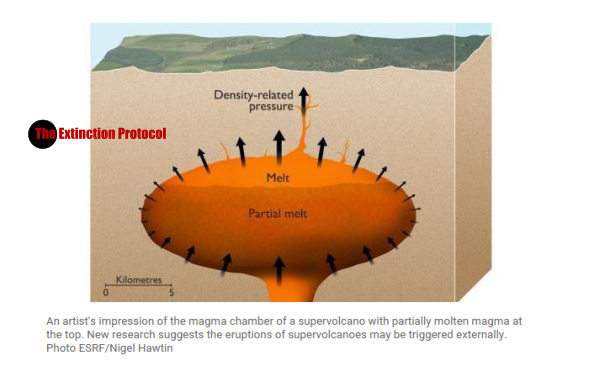| Online: | |
| Visits: | |
| Stories: |

By Extinction Protocol: 2012 Earthchanges and News Event (Reporter)
Contributor profile | More stories
Contributor profile | More stories
| Story Views | |
| Now: | |
| Last Hour: | |
| Last 24 Hours: | |
| Total: | |
Study: triggered internally or externally? Mystery intensifies on what causes supervolcanoes to explode
Thursday, November 5, 2015 7:03
% of readers think this story is Fact. Add your two cents.
November 2015 – WYOMING – Supervolcanoes’ massive eruptions, which have global consequences, require an external trigger, scientists say. The traditional evolution of an erupting volcano involves a steady pressure increase inside the magma chamber. Eventually, the pressure becomes too great and the volcano blows. But a new study, published in the Journal of Volcanology and Geothermal Research, suggests internal triggers fail to explain supervolcanoes. “Typically, when we think about how a volcanic eruption is triggered, we are taught that the pressure in the magma chamber increases until it causes an explosion and the volcano erupts,” lead study author Patricia Gregg, University of Illinois professor of geology, said in a press release. “This is the prevailing hypothesis for how eruptions are triggered. At supervolcanic sites, however, we don’t see a lot of evidence for pressurization.”
Last year, two studies offered the unrealized importance of magma buoyancy as a predictive factor in supervolcano eruptions. To simulate how a supervolcano behaves — a giant chamber holding at least 500 cubic kilometers of magma — Gregg built mathematical models based on the basic laws of physics. When she incorporated the buoyancy findings from earlier studies she found the factor to have a minimal effect on the simulations. “The fact that my numerical model was not agreeing with their analytical solution suggested that there was something missing from the analytical solution. So that prompted me to look closer,” Gregg said. “What they miss in the buoyancy model is Newtonian physics: The magma may push up, but the roof pushes back down.” Gregg’s analysis pointed to another possibility. The pressure on a volcano’s roof could encourage faulting. The models showed that should one of these faults crack open, the magma quickly pushed through — unzipping the entire magma chamber.
Gregg and her colleagues are now working on more complex, four-dimensional models — which require supercomputers to run — to track the evolution of the Yellowstone supervolcano over time. Understanding how external factors on the surface might trigger a supervolcano eruption is key, Gregg says, to predicting a blast. “If we see a correlation between magma chamber size and the ability to erupt, it is important to know if supervolcano eruptions are triggered by internal factors or by foundering and faulting in the roof. It may mean that we have to monitor these volcanoes differently,” Gregg said. “If the trigger is an external force, whether it be an earthquake or a fault, then we should look at seismicity, what types of faults are being developed, what is the stability of the roof, and what kinds of activities are happening on the surface that could cause faulting.” –UPI
Source: https://theextinctionprotocol.wordpress.com/2015/11/05/study-triggered-internally-or-externally-mystery-intensifies-on-what-causes-supervolcanoes-to-explode/





